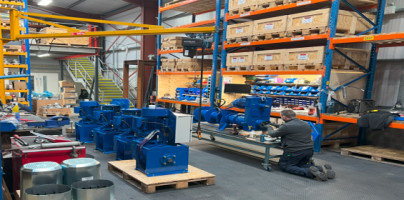Winches for liferafts must be designed with the challenges of maritime operation in mind. Liferafts can be heavy and therefore winches must be engineered to handle the precise load during launch and recovery. There’s also the question of safety. As critical safety equipment, the winch system must be designed to operate reliably in various weather conditions — including on rough seas. Similarly, it must be designed to perform well in saltwater and corrosive atmospheres.
Controlled speed and efficiency are also important factors. During emergencies, time is of the essence and winches are relied upon for quick deployment and retrieval of liferafts. Should a winch fail during an emergency, there are lives at stake. There are also space limitations to consider. Many ships have limited space for the installation of winches, therefore designing a winch required a delicate balance of providing sufficient power and ergonomic functionality.
As a leading liferaft producer for rafts stored on cruise ships, ferries and oil rigs, Survitec approached Technidrive, a specialist systems integrator for integrated drive systems, with a specific brief. It required a winch capable of meeting all the typical challenges of this equipment, but the winch system also needed to be easy to integrate and provide a competitively priced solution. This was particularly important for the ferry segment of Survitec’s buyers, who operate on a particularly narrow margin.
“We immediately recognised that to successfully meet this challenge — and maintain the cost effectiveness the client required — We needed to develop a manual powered winch with the ability to add a service tool for assisted hoisting,” explained Jonathan Johnston the Project System Solution Engineer at Technidrive. “While removing the electrical element may seem like a backward step, this decision actually provided the winch with additional safety measures. Without an electric motor, there was no chance of electrical failure.” The lowering of the rafts is then done completely by gravity with the speed controlled via a centrifugal brake.
As an alternative to a motor, Technidrive incorporated a spring clutch mechanism to control the speed of descent. The team designed a plate to attach to the winch, enabling manual lifting using commonly available tools such as spanners, ratchets, or combi-drills. The entire development process, from concept to prototype, was meticulously documented using 3D design software.
“By utilising our 3D printer, we were able to seamlessly translate CAD drawings into physical prototypes, allowing us to efficiently iterate and test various designs before committing to the final product,” said Johnston. “This streamlined process significantly reduced the time and cost associated with traditional manufacturing methods while providing us with tangible models for evaluation and refinement.”
The design was manufactured and tested on Technidrive's in-house test rig, which replicates real-world conditions to ensure the winch's reliability and safety.
Despite Survitec’s satisfaction, the development process presented its fair share of challenges. One notable hurdle was ensuring safety when adding and removing the tool for raising and lowering the load.
“We discovered through testing that the operator could be at risk of injury if the load was not securely fastened prior to removal of the raising tool,” said Johnston. “Based on the test result, we actioned a safety guard to the input of the winch to prevent any accidental contact with moving parts and ensure the protection of personnel and surrounding equipment.”
”When you come away from a CAD drawing everything looks perfect. Then you go into development and there are teething problems that crop up,” explained Johnston. “Developing a solution like this requires analytical thinking and innovative solutions. This is where Technidrive’s team of engineers really come into their own. Our team’s technical knowledge, paired with our inhouse test rig that mimics the conditions of the product in its future environment, means we can overcome these challenges and develop an expertly engineered solution.”
The implementation of Technidrive's bespoke winch solution resulted in numerous benefits for Survitec. Firstly, the affordability of the solution offered a significant cost advantage over existing options, allowing the company to remain competitive in a challenging market. Secondly, the simplified design eliminated the reliance on electrical components, enhancing the winch's reliability and reducing the risk of malfunctions.
The manual power option also provided ease of maintenance and eliminated potential downtime associated with sourcing and replacing electrical motors. This painstaking task can take anywhere from weeks to months depending on the remoteness of the marine vessel. Instead, a single trip to any DIY store would offer replacement parts such as a ratchet and a spanner.
In addition, the company found the winches aided its sustainability and cost-efficiency objectives. By removing the electric motor and relying on manual power, the solution reduced energy consumption and minimised the company's carbon footprint. Furthermore, the absence of electrical components removed the need for electrical infrastructure and reduced dependence on external power, making it a greener and more versatile choice.
While this example demonstrates Technidrive's winch solutions for the marine sector, these systems have potential for broader applications in industries, including quarrying and agriculture — all sectors in which ease of maintenance, affordability and sustainability are vital. By staying at the forefront of mechanical engineering and customisation, Technidrive aims to make a lasting impact on safety, affordability and efficiency in the maritime and beyond.
https://www.linkedin.com/company/technidrive-ltd/

